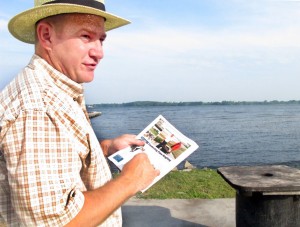Low lake levels not a worry for local fishing centre
By Renée Rodgers

PICTON, Ont. (20/07/11) Todd Foster, owner of Foster's Fishing Centre, compares a photo of his shoreline published in Ontario Out of Doors to what the same section of shoreline looks like now. The photo was taken in the spring of 2010, when the Bay of Quinte water level was very low. Photo by Renee Rodgers.
Quinte Conservation is carefully monitoring low lake levels, but the owner of Foster’s Fishing Centre isn’t worried about the Bay of Quinte yet.
Todd Foster, owner of Foster’s Fishing Centre on the Bay of Quinte in Picton, has lived next to the bay for 40 years. His 45-acre campground hosts hundreds of anglers every year, many of them eager to catch the large walleye the area is known for.
He said the water on the Bay of Quinte has dropped about 10 inches since it peaked around the middle of June due to heavy rainfalls during the previous month. Yet, according to his experience, the level is about where it should be this time of year.
Quinte Conservation began talking of low lake levels in the northern part of the Quinte watershed in early July. Terry Murphy, general manager of Quinte Conservation, said water levels began to drop due to heat and lack of rainfall in the area at that time. The problem then spread to most other lakes in the watershed.
The Quinte watershed is an 18,000-square kilometer area of land that catches the rain and snow that eventually drains into the Bay of Quinte or Lake Ontario. About 400,000 people live in the area, according to Lower Trent Conservation’s website.
Murphy said the low water situation was a complete turnaround from April and May – high lake levels in the watershed due to an influx of rain.
“A month ago we were getting complaints about high levels and then two weeks later we’re getting complaints about low levels,” he said. “We had so much rain in April and May and parts of June … but then most of June and July we had no rain at all.”
The rise and fall is no surprise to Foster, who said he’s used to the water level on the Bay of Quinte constantly changing.
Murphy said the people most affected by fluctuating water levels are people involved with recreational activities on the water, something Foster knows all about.
For example, Foster said low water levels affect anglers who wish to launch their boats from his campground.
“Last spring the water never came up,” he said. “As a result, I have boaters coming in here, they have problems because now they’re in shallow water – they ding their propellers.”
Also, lower water levels mean a higher climb from boat to dock.
“My docks are all set for normal conditions, so now some poor guy, in order to get out of his boat if he’s a senior citizen, he almost needs a ladder,” Foster said.
Slightly lower lake levels also mean more sunlight reaches the bottom of the lake, encouraging weed growth, said Murphy. Heavy weed does affect boaters, Foster said, when weeds get tangled up in motorboat propellers.
Foster said he and his wife have plans to turn their fishing centre into more of a family campground. He would like to add sand to his shoreline to create a more attractive beach, but changing water levels make that hard to do.
“It’s hard to develop a tourist shoreline because of it,” he said. “You try to make your beaches so they operate properly at a certain water level and if that water level goes away, your sandy beach can be left high and dry.”
Then there are the random tasks that fluctuating water levels necessitate.
“Buoys have to be adjusted constantly to mark our channels,” he said. “You want your buoys to be able to be over top of what you’re marking. I think three times this spring, as the water level was coming up through May, we had to go out and adjust our buoys to make sure they didn’t just go under water.”
Watershed residents don’t need to be overly concerned about the low water levels, Murphy said. Quinte Conservation is not worried about a water shortage at this point.
“We were so used to having so much rain all spring, and so much water that the low conditions now I think seem more drastic to people,” he said.
Murphy said Quinte Conservation will continue to monitor the situation.
 Print This Post
Print This Post






